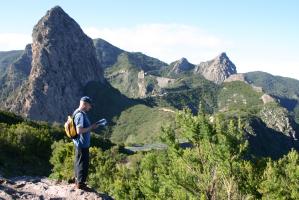When Is the Best Time to Go to the Canary Islands?
With year-round sunshine, spring-like temperatures, and minimal rainfall, it’s never exactly a bad time to visit the Canaries.
But from seasonal island-to-island weather differences, to wildlife-spotting opportunities and local festivities, timing it just right can make all the difference to your trip.
We’ve laid out a few key points to help you decide on the best time to go to the Canary Islands.
When’s the Weather at its Best in the Canary Islands?
First thing’s first: the weather. The chances are, whether it’s the height of summer or the depths of winter, the temperatures on the islands are going to be a major consideration when you’re planning a trip.
| Month | Avg Temperature (º) | Avg Rainfall (mm) |
| January | 18 | 29 |
| February | 18 | 24 |
| March | 19 | 16 |
| April | 20 | 6 |
| May | 21 | 2 |
| June | 23 | 0 |
| July | 25 | 0 |
| August | 26 | 0 |
| September | 25 | 6 |
| October | 23 | 20 |
| November | 21 | 33 |
| December | 19 | 31 |
As the chart above shows, the Canary Islands are at their hottest in the high summer months of July to August.
By early autumn, those sultry summer temperatures have quickly started to drop. September to November sees warm sunny days, with cooler mornings and evenings - perfect for more active breaks.
Autumn gives way to a short - and invariably pretty sunny - winter from December to February, before a beautiful spring sets in from March to May.
Across the board, with an average of around 3,000 hours of sunshine per year, the islands are right up there amongst the sunniest places in Europe.
Which Is the Hottest Island?
As for which of the Canary Islands is the hottest, Lanzarote consistently sees the highest year-round temperatures.
The nearest of the Canaries to the west coast of Africa, it can be regularly visited by ‘calima’, a hot, dry wind rolling in from the Sahara Desert and enveloping the island in a dusty orange cloud.
At the other end of the spectrum, La Gomera is the mildest of the Canary Islands - with the warmest October to March temperatures - giving rise to its nickname of the ‘Island of Eternal Spring’.
Licked by easterly Atlantic trade winds, particularly on the north side of the island, it’s also lacking in humidity during the summer.
What Time of Year’s Rainiest?
In terms of when they’re at their wettest, October through to March sees the highest rainfall levels, with November and December the months when you typically see the most millimetres of rain.
But we’re hardly talking biblical levels at any time of year, no matter which island you’ve based yourself on. As a few points of comparison, Maastricht sees around 64mm, Manchester 87mm, Munich 92mm, and Massachusetts 103mm per month.
Major Events Worth Planning Around
As is the case with mainland Spain, the Canary Islands aren’t short of a vibrant local fiesta or two.
Whether it’s February’s carnivals bursting with colour, or the solemn pilgrimages and summer fiestas that fill streets and squares with music and partying, the calendar’s peppered with cultural highlights.
Carnival is the major event in the calendar. In 2026, it falls from mid-February to early March, with the exact dates ranging from island to island.
La Palma: The highlight of La Palma’s Carnival is Los Indianos (visitlapalma.es) which hits the capital, Santa Cruz, in a noisy tidal wave of talcum powder battles, traditional-style fancy dress, parades and partying.
Religious events and local harvest festivals of note include the Fiesta de San Antonio del Monte (Garafía, mid-June), La Fiesta del Diablo (Tijarafe, 8th September) Corpus Christi (Villa de Mazo, June), and the celebration of almond blossom season, the Fiesta del Almendro (Puntagorda, end of January).
Tenerife: The island’s huge carnival celebrations take place in Santa Cruz de Tenerife between late January and early March.
Other local festivals worth keeping an eye out for include La Orotrava’s flower-adorned Corpus Christi celebrations (May-June; webtenerife.co.uk), the Fiestas de la Cruz (early May), and the Virgen de la Candelaria pilgrimage (Candelaria, mid-August).
Gran Canaria: One of the largest and liveliest carnivals is best experienced in Las Palmas or Maspalomas. Other dates to mark in the diary include Las Palmas’ Fiestas Fundacionales (grancanaria.com) that run throughout June, celebrating the founding of the island in 1478.
La Gomera: Aside from its carnival, tiny La Gomera is home to some pretty big festivals and fiestas over the course of the year. A particular highlight - with religious ceremonies, processions and traditional music taking place across the island - is the Fiesta de la Virgen de las Nieves (late July/early August; lagomera.travel).
Other Seasonal Highlights
When to go for bird watching: As you'd expect of somewhere named after a bird, the islands are a twitcher's paradise. The best time to visit for a spot of bird-watching is spring into early summer (March-June) as it's breeding season for many of the more interesting, and frequently quite rare, species.
The pine forests of Gran Canaria are home to the endemic Canary Woodpecker, while La Gomera's Garajonay National Park is home to White-tailed Laurel Pigeons and unique Goldcrests. You can also spot endangered Blue Chaffinches on Tenerife, and the island's dense laurel forests are also home to similarly rare Bolle's Pigeons.
When to go for botany: As well as fabulous fauna, the Canary Islands are home to some unique flora. After the cooler temperatures and rains of winter, spring (March to May) is the best time to visit to see some beautiful flowering plants from bellflowers and Tajinastes to the striking bird of paradise flower.
When to go for hiking: Autumn into early winter - October to December - sees perhaps the perfect temperatures for a walking holiday, with January to March also ideal for a mix of hiking and winter sun.
Planning a walking holiday in the Canary Islands? Have a look at our selection of self-guided tours.
The Canary Islands in pictures
Marketing, Web & Design
After studying in my hometown of Barcelona and spending several years abroad, I relocated in 2018 to Cabrales, a beautiful rural area in Northern Spain. I invite you to check out some photos of Cabrales to see the incredible views we enjoy from our office!
After a few years in reservations, I now manage the website and marketing for S-Cape Travel, where I handle design tasks, blog writing, and attend specialized travel fairs.



















Opening hours: Mon-Fri 9:00am – 6:00pm (CET)
Opening hours: Mon-Fri 9:00am – 6:00pm (CET)